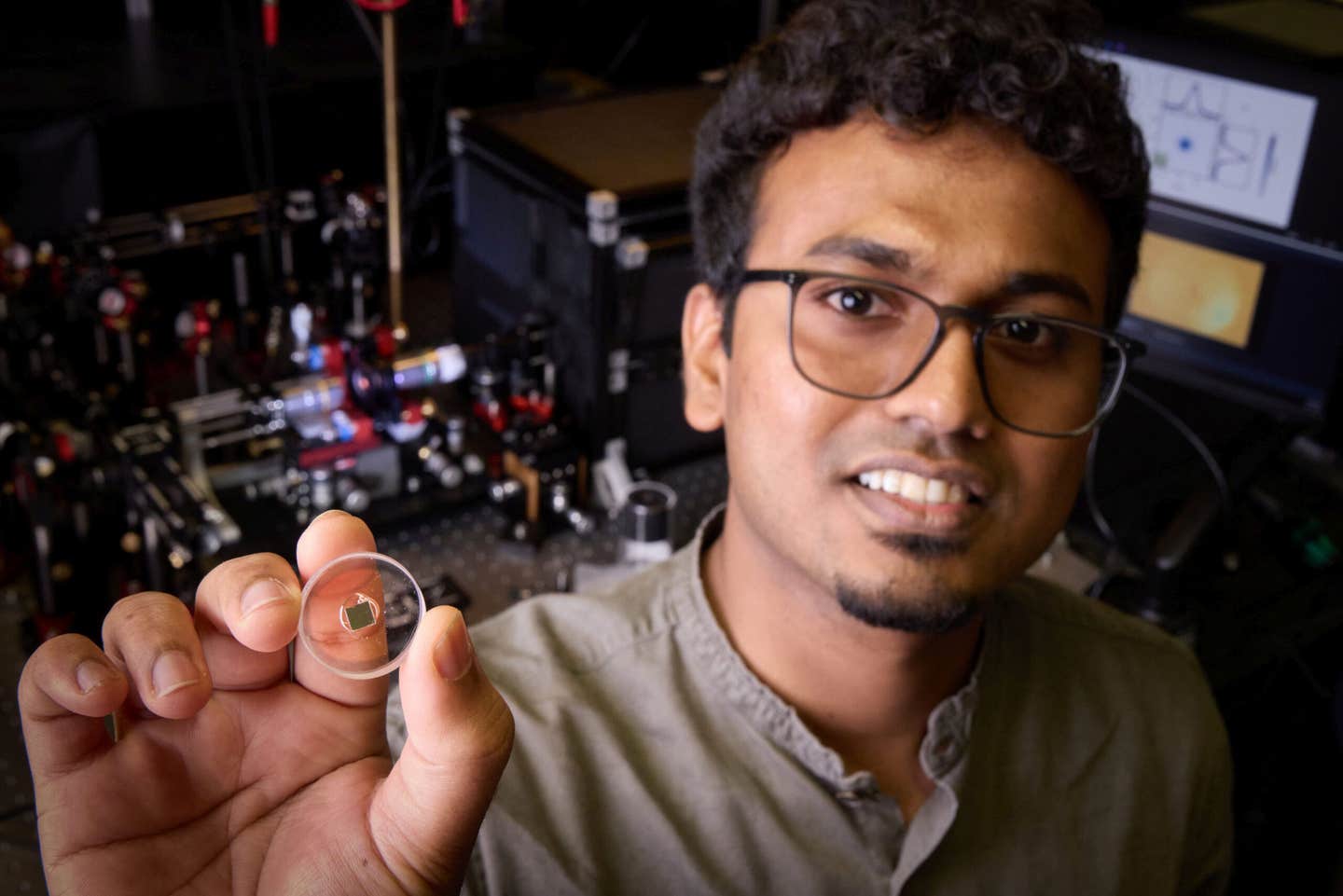Weird science: Physicists create a one-dimensional gas out of light
Physicists from the University of Bonn and RPTU have created a one-dimensional photon gas, allowing the testing of quantum effects in this exotic state. Their findings could open up new areas for quantum optical applications.

These polymers act like a type of gutter, but in this case for light,” explains Kirankumar Karkihalli Umesh. (CREDIT: Volker Lannert)
Physicists from the University of Bonn and the University of Kaiserslautern-Landau (RPTU) have successfully created a one-dimensional gas composed of light particles.
This breakthrough allows for the testing of theoretical predictions about this exotic state of matter, marking the first time such an experiment has been conducted. The method used in their research could open new doors for studying quantum effects. Their findings have been published in Nature Physics.
To understand how this works, think of how water behaves. If you direct a jet of water into a large pool, the effect on the water level is minimal because the water disperses across the entire surface. Now, imagine directing that same jet of water into a narrow gutter.
Instead of dispersing, the water creates a wave that travels in a confined direction, limited by the gutter’s walls. The narrower the gutter, the more pronounced and focused the wave becomes, resembling a one-dimensional effect.
The team of researchers, led by Dr. Frank Vewinger from the University of Bonn's Institute of Applied Physics (IAP), aimed to replicate this kind of dimensional control with light particles, or photons. "To create these types of gases, we need to concentrate lots of photons in a confined space and cool them simultaneously," Vewinger explains.
In this experiment, the researchers collaborated with their counterparts from the RPTU, including Prof. Dr. Georg von Freymann’s group, to explore how the dimensionality of photon gases can be manipulated.
Related Stories:
The researchers used a tiny container filled with a dye solution, exciting it with a laser. The photons inside the container bounced back and forth between its reflective walls. As the photons collided with dye molecules, they cooled until forming a condensed photon gas.
The team could adjust the dimensionality of the gas by altering the reflective surface of the container. By applying a transparent polymer to the surfaces, they created microscopic protrusions that trapped the photons, allowing them to behave in a one- or two-dimensional way.
"These polymers act like a type of gutter, but in this case for light," explains Kirankumar Karkihalli Umesh, the lead author of the study. He further describes how narrowing the gutter makes the photon gas behave more one-dimensionally. This confinement is crucial for understanding how quantum gases behave when restricted to fewer dimensions.
In two dimensions, the temperature at which condensation occurs is fixed, similar to how water freezes at zero degrees Celsius. Physicists refer to this as a phase transition. However, when dealing with a one-dimensional photon gas, things get more complicated. Vewinger explains that "thermal fluctuations"—small disturbances in the system—play a larger role in one-dimensional systems than in two-dimensional ones.
These fluctuations disrupt the order within the gas, causing different regions of the gas to behave differently. As a result, the phase transition that is so well-defined in two-dimensional systems becomes less distinct, or "smeared out," in a one-dimensional system.
Despite this smearing effect, the behavior of one-dimensional gases is still governed by quantum physics. These systems are known as degenerate quantum gases, where quantum effects dominate even though the gas doesn’t transition cleanly into a condensed state. It’s like water turning into a slushy form without ever fully freezing. Vewinger notes, "We have now been able to investigate this behavior at the transition from a two-dimensional to a one-dimensional photon gas for the first time."
The team demonstrated that one-dimensional photon gases don’t have a precise condensation point. By making subtle changes to the polymer structures on the reflective surfaces, the researchers can now explore phenomena occurring at the transition between different dimensionalities. Although their work is still considered basic research, it has the potential to open up new avenues for quantum optical effects, which could lead to technological applications in the future.
This work represents a significant step in understanding quantum gases and the ways in which dimensionality influences their behavior. The collaboration between the University of Bonn and RPTU not only advances our knowledge of quantum physics but also highlights the importance of interdisciplinary research in pushing the boundaries of what’s possible in modern science.
Note: Materials provided above by The Brighter Side of News. Content may be edited for style and length.
Like these kind of feel good stories? Get The Brighter Side of News' newsletter.
Joshua Shavit
Science & Technology Writer | AI and Robotics Reporter
Joshua Shavit is a Los Angeles-based science and technology writer with a passion for exploring the breakthroughs shaping the future. As a contributor to The Brighter Side of News, he focuses on positive and transformative advancements in AI, technology, physics, engineering, robotics and space science. Joshua is currently working towards a Bachelor of Science in Business Administration at the University of California, Berkeley. He combines his academic background with a talent for storytelling, making complex scientific discoveries engaging and accessible. His work highlights the innovators behind the ideas, bringing readers closer to the people driving progress.



